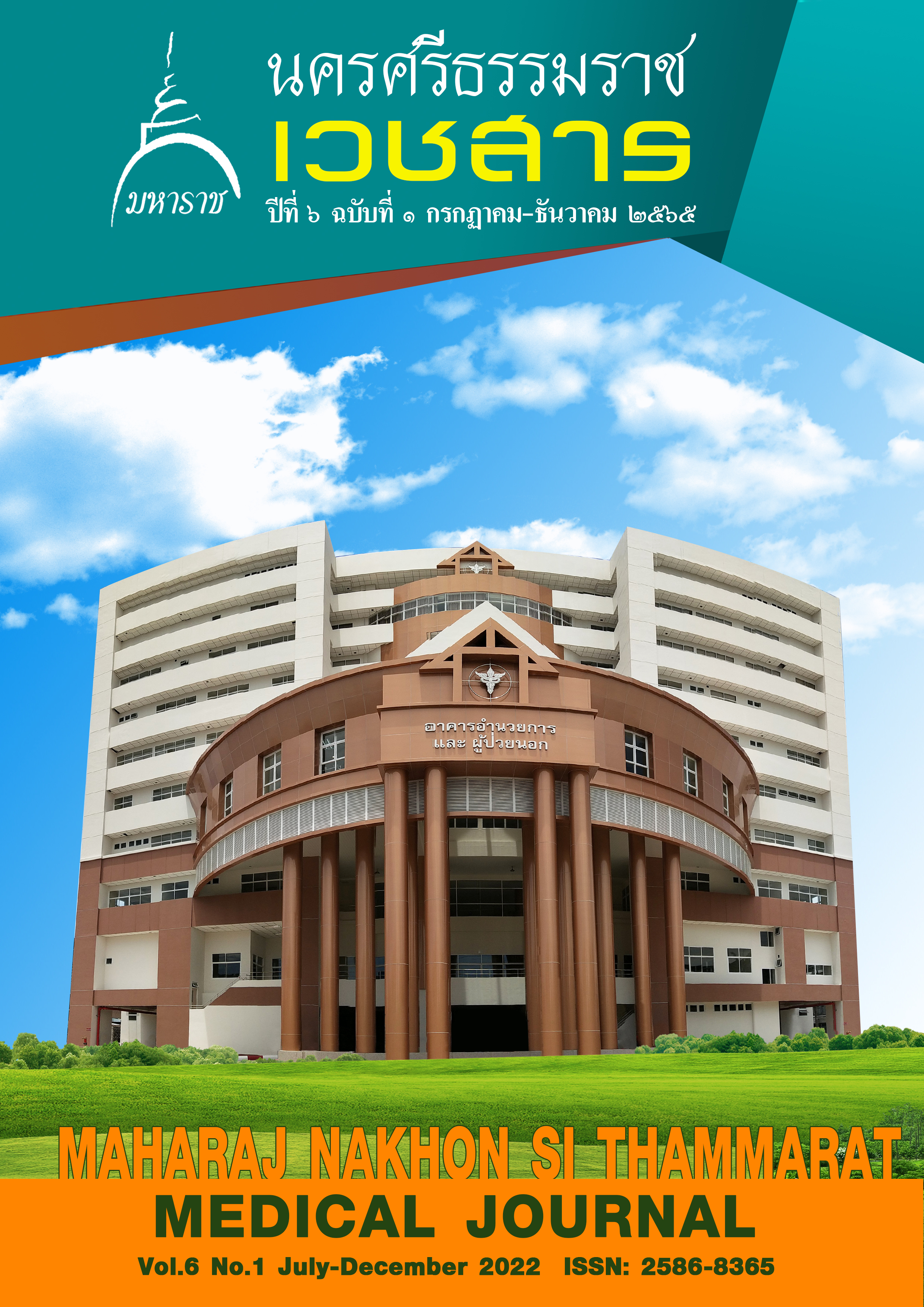การศึกษาผลลัพธ์ระยะสั้นหลังผ่าตัดของการผ่าตัดเปลี่ยนข้อเข่าเทียมข้างเดียวและสองข้าง
คำสำคัญ:
โรคข้อเข่าเสื่อม, การผ่าตัดเปลี่ยนข้อเข่าเทียมบทคัดย่อ
บทนำ : ในปัจจุบันจำนวนประชากรผู้สูงอายุเพิ่มมากขึ้น ผู้สูงอายุที่ได้รับการวินิจฉัยเป็นโรคข้อเข่าเสื่อมมีจำนวนเพิ่มขึ้นเช่นกันผู้ป่วยอาจจำเป็นต้องได้รับรักษาโดยการผ่าตัดเปลี่ยนข้อเข่าเทียมซึ่งผลลัพธ์ค่อนข้างดี ผู้ป่วยหายปวดเข่า และกลับไปใช้ชีวิตประจำวันได้ดีขึ้น แต่ยังมีผู้ป่วยจำนวนหนึ่งในโรงพยาบาลมหาราชนครศรีธรรมราชที่ยังไม่มั่นใจผลลัพธ์ของการผ่าตัดกลัวต้องนอนรักษาในโรงพยาบาลหลายวัน และอาการปวดหลังผ่าตัด อาจทำให้ปฏิเสธการผ่าตัด จึงเป็นที่มาของการศึกษานี้
วัตถุประสงค์ : เพื่อศึกษาผลลัพธ์ระยะสั้นของการผ่าตัดข้อเข่าเทียมข้างเดียวและสองข้างในโรงพยาบาลมหาราชนครศรีธรรมราช
วัสดุและวิธีการศึกษา : การศึกษาแบบย้อนหลัง จากข้อมูลเวชระเบียนผู้ป่วยนอกและผู้ป่วยใน ในผู้ป่วยที่ได้รับการวินิจฉัยข้อเข่าเสื่อมที่ได้รับการผ่าตัด ระหว่างเดือนสิงหาคม 2563 ถึงเดือนสิงหาคม 2564 โดยดูข้อมูลพื้นฐาน และผลลัพธ์หลังการผ่าตัด
ผลการศึกษา : ผู้ป่วยข้อเข่าเสื่อมที่ได้รับการผ่าตัดเปลี่ยนข้อเข่าเทียม จำนวน 40 ราย มีคุณสมบัติที่เข้าได้กับการศึกษาในครั้งนี้ 39 ราย แบ่งเป็นผู้ป่วยที่ผ่าตัดเปลี่ยนข้อเข่าเทียมข้างเดียว 29 ราย และผ่าตัดเปลี่ยนข้อเข่าเทียมสองข้างในคราวเดียว 10 ราย มีอายุเฉลี่ย 69.51 และ 64.30 ปี ดัชนีมวลกายเฉลี่ย 26.53 และ 27.53 กก.ม2 มีระดับความปวดเฉลี่ยในวันแรก (VAS) 2.93 และ 3.40 ในวันที่สอง 2.96 และ 2.90 ได้รับยาแก้ปวดมอร์ฟีนเฉลี่ย 3.30 และ 2.40 มิลลิกรัมเสียเลือดโดยวัดจากความเข้มข้นเลือดร้อยละ 4.03 และ 4.80 นอนรักษาตัวในโรงพยาบาลเฉลี่ย 3.93 วัน และ 4.00 วันตามลำดับ โดยผู้ป่วยทุกรายเดินได้ใน 24 ชั่วโมงหลังผ่าตัดและไม่พบภาวะแทรกซ้อน
สรุป: ผลการรักษาของการผ่าตัดเปลี่ยนข้อเข่าเทียมข้างเดียว และการผ่าตัดเปลี่ยนข้อเข่าเทียมทั้งสองข้างในคราวเดียวกันได้ผลดี โดยผู้ป่วยมีอาการปวดไม่มากไม่มีภาวะแทรกซ้อนสามารถเดินได้ภายใน 24 ชั่วโมง ผู้ป่วยกลับบ้านได้เร็ว ทำให้ผู้ป่วยสามารถกลับไปใช้ชีวิตประจำวันได้เร็วขึ้น
คำสำคัญ : โรคข้อเข่าเสื่อม การผ่าตัดเปลี่ยนข้อเข่าเทียม
เอกสารอ้างอิง
Wallace I, Worthington S, Woods R, Lieberman D. Knee osteoarthritis has doubled in prevalence since the mid-20th century. Proc Natl Acad Sci U S A2017; 114(35):9332-6.
Felson D. Epidemiology of hip and knee osteoarthritis. Epidemiol Rev 1988; 10(1): 1-28.
Mora J, Przkora R, Cruz-Almeida Y. Knee osteoarthritis: pathophysiology and current treatment modalities. J Pain Res 2018; 11: 2189-96.
Du Souich P. Comments on “OARSI guidelines for the non-surgical management of knee osteoarthritis”. Osteoarthritis Cartilage 2014; 22(6): 888-9.
Walker L, Clement N, Deehan D. Predicting the Outcome of Total Knee Arthroplasty Using the WOMAC Score: A Review of the Literature. J Knee Surg 2019; 32(8): 736-41.
Roos EM, Lohmander LS. The Knee injury and Osteoarthritis Outcome Score (KOOS): from joint injury to osteoarthritis. Health Qual Life Outcomes 2003; 1: 64.
Perruccio AV, Davis AM. The development of a short measure of physical function for knee OA KOOS-Physical Function Shortform (KOOS-PS) - an OARSI/OMERACT initiative. Osteoarthritis Cartilage 2008; 16(5): 542-50.
Kazis LE, Fincke RG. Patient-reported measures of health: The Veterans Health Study. J Ambul Care Manage 2004; 27(1): 70-83.
Powell R, Pulido P, Tuason M, Colwell C, Ezzet K. Bilateral vs Unilateral Total Knee Arthroplasty: A Patient-Based Comparison of Pain Levels and Recovery of Ambulatory Skills. J Arthroplasty 2006; 21(5): 642-9.
Malahias M, Manolopoulos P, Nikolaou V, Sculco P. Safety and outcome of simultaneous bilateral unicompartmental knee arthroplasty: A systematic review. J Orthop 2021; 24: 58-64.
Berend K, Lombardi A, Adams J. Perioperative Complications of Simultaneous versus Staged Unicompartmental Knee Arthroplasty. Clin OrthopRelat Res 2011; 469(1): 168-73.
Alghadir A, Iqbal Z, Anwer S, Anwar D. Comparison of simultaneous bilateral versus unilateral total knee replacement on pain levels and functional recovery. BMC Musculoskelet Disord 2020; 21(1): 246.
Bakirhan S. Comparison of early postoperative functional activity levels of patients undergoing unilateral and bilateral total knee arthroplasty. Acta Orthop Traumatol Turc 2009; 43(6): 478-83.
Harnik A, Hilton R. The Evaluation of Single-Sided Total Knee Arthroplasty Versus Simultaneous Bilateral Total Knee Arthroplasty Improvements and Postoperative Progression Based on Patient-Based Outcome Scoring: A Rural Retrospective Clinical Orthopaedic Study. J Am AcadOrthop Surg Glob Res Rev 2019; 3(7): e069.
Barad S, Howell S, Tom J. Is a shortened length of stay and increased rate of discharge to home associated with a low readmission rate and cost-effectiveness after primary total knee arthroplasty? Arthroplast Today 2015; 4(1): 107-12.
Memtsoudis SG, Ma Y, González Della Valle A, Mazumdar M, Gaber-Baylis LK, MacKenzie CR, et al. Perioperative outcomes after unilateral and bilateral total knee arthroplasty. Anesthesiology 2009; 111(6): 1206-16.
ดาวน์โหลด
เผยแพร่แล้ว
รูปแบบการอ้างอิง
ฉบับ
ประเภทบทความ
สัญญาอนุญาต

อนุญาตภายใต้เงื่อนไข Creative Commons Attribution-NonCommercial-NoDerivatives 4.0 International License.
เนื้อหาและข้อมูลในบทความที่ลงตีพิมพ์ในมหาราชนครศรีธรรมราชเวชสาร ถือเป็นข้อคิดเห็นและความรับผิดชอบของผู้เขียนบทความโดยตรงซึ่งกองบรรณาธิการวารสาร ไม่จำเป็นต้องเห็นด้วย หรือร่วมรับผิดชอบใด ๆ
บทความ ข้อมูล เนื้อหา รูปภาพ ฯลฯ ที่ได้รับการตีพิมพ์ในมหาราชนครศรีธรรมราชเวชสาร ถือเป็นลิขสิทธิ์ของมหาราชนครศรีธรรมราชเวชสาร หากบุคคลหรือหน่วยงานใดต้องการนำทั้งหมดหรือส่วนหนึ่งส่วนใดไปเผยแพร่ต่อหรือเพื่อกระทำการใด จะต้องได้รับอนุญาตเป็นลายลักษณ์อักษรจากวารสารมหาราชนครศรีธรรมราชเวชสาร ก่อนเท่านั้น



